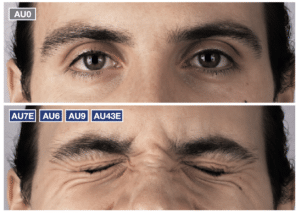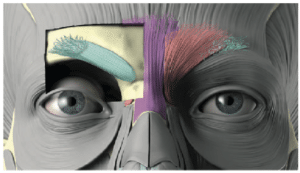Understanding Forehead Muscles: Injecting the Corrugator, Frontalis, and Orbicularis Muscles to Prevent Brow Droop
Injecting neuromodulators like Botox, Jeuveau, and Dysport into the forehead requires a detailed understanding of the underlying anatomy and the function of the muscles involved. The forehead is a complex area where muscles that lift and muscles that pull down the eyebrows are constantly at odds. Injecting without considering this tug-of-war can lead to undesired effects like brow droop, an unnatural appearance, or even a frozen forehead. In this post, we’ll explore the different muscles in the forehead, how neuromodulators affect each one, and the importance of precision and balance in injection technique to prevent brow droop.
The Muscles of the Forehead
The muscles in the forehead are responsible for creating facial expressions and controlling the movement of the brows. Understanding the functions of the frontalis, orbicularis oculi, corrugators, and procerus muscles is key to injecting neuromodulators correctly and achieving a natural result.
1. Frontalis Muscle
- Function: The frontalis is the only muscle in the forehead that lifts the brows. It spans the entire forehead from the eyebrows to the hairline. When you raise your eyebrows in surprise or open your eyes wide, you’re engaging the frontalis.
- Effect of Neuromodulator: Injecting neuromodulators into the frontalis weakens its lifting action, smoothing out horizontal lines on the forehead. However, over-injecting can result in brow ptosis (brow droop) because the muscle can no longer counterbalance the downward pull of the muscles around the eyes.

2. Orbicularis Oculi Muscle
- Function: The orbicularis oculi is a circular muscle that surrounds the eye and is responsible for closing the eyelids and creating crow’s feet wrinkles at the outer corners of the eyes when you smile or squint. It also pulls the brow down.
- Effect of Neuromodulator: Injecting neuromodulators into the orbicularis oculi softens crow’s feet wrinkles and reduces the muscle’s ability to pull the brow down, which can create a subtle brow lift when done correctly.
 .
. 
3. Corrugator Supercilii Muscle
- Function: The corrugators are located at the inner part of the eyebrows and run diagonally toward the center of the forehead. When activated, they pull the eyebrows inward and downward, creating vertical frown lines between the brows (often called “11 lines”).
- Effect of Neuromodulator: Injecting the corrugators with a neuromodulator softens these frown lines and reduces the downward pull on the brows. Proper placement of the injections in this muscle can create a more open, relaxed look without affecting the frontalis.

4. Procerus Muscle
- Function: The procerus is a small muscle located at the bridge of the nose, just above the nasal bone. It pulls the skin between the eyebrows down, contributing to horizontal lines at the top of the nose, often called the “bunny lines.”
- Effect of Neuromodulator: Injecting the procerus reduces the muscle’s downward pull, smoothing the lines at the root of the nose and softening the expression of anger or frustration.

The Tug-of-War: Muscles That Raise vs. Muscles That Pull Down
The frontalis muscle is the sole elevator of the eyebrows, while the orbicularis oculi, corrugators, and procerus muscles all contribute to pulling the brows down. This creates a tug-of-war effect across the forehead: when the muscles that pull down are stronger or more active, the brows lower. Conversely, when the frontalis is dominant, the brows lift.
When you inject neuromodulators into the forehead, it’s important to consider the balance between these opposing muscle groups. If you relax the frontalis too much without addressing the muscles that pull down the brows, you risk brow ptosis or droop. On the other hand, weakening the muscles that pull down, while leaving the frontalis active, can create a subtle brow lift. This balancing act is the foundation of an effective forehead neuromodulator treatment.
Achieving Balance with Neuromodulators
A well-balanced forehead injection involves precise and strategic dosing across all the involved muscle groups:
Frontalis Injections: It’s important to inject only small amounts of neuromodulator into the frontalis, especially in the lower half of the forehead. This preserves some of its lifting action. Avoid injecting too close to the eyebrows, as this can eliminate the frontalis’ ability to counteract the downward pull of other muscles.
Orbicularis Oculi Injections: Neuromodulators are commonly injected into the orbicularis oculi to reduce crow’s feet. These injections have a secondary benefit of slightly relaxing the downward pull on the lateral part of the eyebrows, which can lead to a subtle lift in the outer brow.
Corrugator Injections: Correctly injecting the corrugators is crucial because of their proximity to the frontalis muscle. Injecting too low or too superficially could inadvertently affect the frontalis, leading to brow heaviness or droop. Therefore, medial corrugator injections should be placed deeper into the muscle, while lateral injections can be more superficial.
Procerus Injections: The procerus is a much smaller muscle compared to the frontalis or corrugators, so it requires less neuromodulator. Injecting the procerus will relax the area between the brows, reducing frown lines and helping to open up the appearance of the brow area.
By balancing the injections across all these muscles, you can achieve a natural look with smooth forehead lines and well-positioned brows.
Injecting the Corrugator Muscle: A Key to Preventing Brow Droop
Injecting the corrugator muscle requires particular attention because of its overlap with the frontalis. If you inadvertently inject into the frontalis while treating the corrugators, you may weaken the ability of the frontalis to lift the brows, leading to brow heaviness or droop.
To avoid this, follow these guidelines:
- Medial Injections: When injecting the corrugator near the glabella (the area between the eyebrows), it’s important to go deeper. The corrugator muscle sits below the frontalis at this point, so a deeper injection will ensure that you’re targeting the right muscle.
- Lateral Injections: As you move more laterally along the corrugator, you can inject more superficially because the muscle is closer to the skin in this region. Going too deep here could affect other muscles, including the frontalis.
Precision in Neuromodulator Choice: Why Jeuveau Is My Preference
In my experience, Jeuveau offers a level of precision that sets it apart from other neuromodulators like Dysport. While Dysport is known for its ability to diffuse more widely into the surrounding tissue, this characteristic can be a disadvantage when treating areas near delicate muscles like the frontalis.
Jeuveau tends to stay more localized at the injection site, which allows for greater precision in controlling the muscle action. This means you can inject Jeuveau into the corrugators without worrying as much about diffusion into the frontalis, reducing the risk of brow droop. It also gives more control over fine-tuning muscle relaxation to achieve a balanced result, ensuring that the patient maintains a natural appearance without unwanted side effects like brow heaviness.
Conclusion
Injecting neuromodulators in the forehead is both an art and a science. To prevent brow droop and achieve a smooth, balanced appearance, it’s crucial to understand the tug-of-war between the frontalis (which lifts the brows) and the orbicularis oculi, corrugators, and procerus (which pull the brows down). By balancing your injections across these muscles and being mindful of the anatomy—especially the overlap between the corrugators and frontalis—you can achieve natural-looking results with minimal side effects.
In my experience, using Jeuveau provides added precision, helping to avoid unwanted diffusion into surrounding muscles. With the right technique and careful product selection, you can smooth forehead lines while maintaining natural brow position and facial expression.

